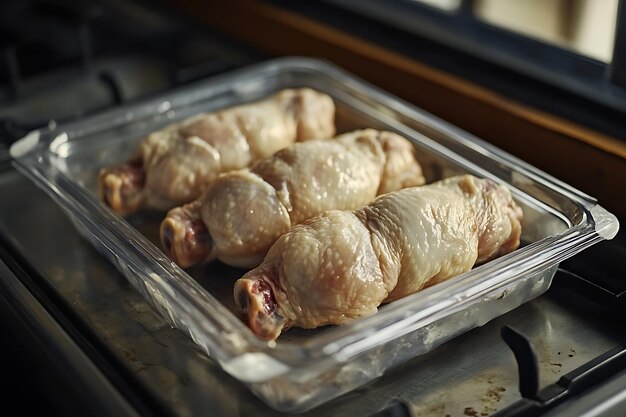How Long Is Raw Chicken Good For in the Refrigerator?
When it comes to storing raw chicken, knowing how long it's safe in your refrigerator is essential for food safety. Leaving chicken in the fridge for too long can lead to foodborne illnesses, a concern for both home cooks and culinary novices. In this guide, we'll explore how you can maximize shelf life and maintain the quality of your poultry, as well as other valuable tips to ensure your meals are both delicious and safe.
🕒 Understanding the Shelf Life of Raw Chicken
Raw chicken, when stored in the refrigerator, has a relatively short shelf life. Typically, raw chicken is good for 1-2 days when kept at a temperature below 40°F (about 4°C). Understanding the factors that influence this duration and how to manage them can help you maintain food safety effectively.
Key Factors Influencing Shelf Life
Temperature: The colder your fridge, the slower bacteria can grow. Ensure your refrigerator is at 40°F or colder.
Packaging: Vacuum-sealed packaging can extend shelf life by limiting air exposure, reducing the risk of spoilage.
Freshness at Purchase: The fresher the chicken when you buy it, the longer it will remain safe in the fridge.
Placement in the Refrigerator: Store chicken on the bottom shelf to prevent juices from contaminating other foods.
📦 Best Practices for Storing Raw Chicken
Implementing some practical storage strategies can ensure your chicken stays as fresh as possible during its fridge life.
Packaging Tips
Keep it Sealed: Use airtight containers or leave the chicken in its original packaging. If you're repackaging, wrap the chicken tightly in plastic wrap and place it in a sealable plastic bag to prevent leaks.
Use Vacuum Seals: Investing in a vacuum sealer can extend the shelf life by removing air and sealing in freshness.
Refrigerator Organization
Designate a Space: Always store raw chicken on the lowest shelf to prevent any drips from contaminating other foods. This is especially important for foods meant to be eaten raw, like fruits and salads.
Labeling: Mark the package with the date of purchase so you can keep track of how long it's been in the fridge.
👍 How to Tell If Raw Chicken Has Gone Bad
Even if kept within the recommended time frame, it's best to check for signs of spoilage before using raw chicken.
Indicators of Spoiled Chicken
Smell: A sour or ammonia-like odor is a reliable sign your chicken has gone bad.
Color: Chicken should be pink, not gray. Any discoloration might indicate spoilage.
Texture: If the chicken feels slimy, it's best to discard it immediately.
Pro Tips for Safety
Use Your Senses: Always do a quick check using sight, smell, and touch before cooking.
Err on the Side of Caution: When in doubt, throw it out. The cost of food safety is far less than a trip to the doctor.
🥶 Can You Extend the Shelf Life? Consider Freezing
If you don't plan on using the chicken within a day or two, freezing is a great alternative to keep it fresh longer.
Freezing Tips
Pre-Freeze Prep: Pat the chicken dry with paper towels before freezing to avoid ice crystals, which can negatively impact texture.
Portion Control: If freezing in batches, divide chicken into portions you'd typically cook in one go. This prevents thawing and refreezing, which can affect quality.
Label Clearly: Note the freezing date on the package. While chicken can be frozen indefinitely, for optimal taste, it's best to use it within 9 months.
🧊 Thawing: The Safe Way
Improper thawing can substantially increase the risk of foodborne illnesses.
Safe Thawing Methods
Refrigerator Thawing: Transfer frozen chicken to the fridge a day before you're planning to cook it. This method keeps the chicken at a safe temperature as it thaws.
Cold Water Bath: Submerge chicken in cold water, changing the water every 30 minutes. Cook immediately after thawing.
Microwave Thawing: If strapped for time, use the microwave's defrost setting. Be mindful to cook the chicken immediately post-thaw to avoid bacteria growth.
🍗 Cooking with Confidence
Understanding chicken shelf life isn't just about safety; it also contributes to enhanced flavor and texture in your dishes.
Cooking Tips for Optimal Flavor
Even Cooking: Bring the chicken to room temperature just before cooking. This ensures even cooking.
Proper Cooking Temperatures: Ensure the chicken is cooked to an internal temperature of 165°F (74°C) to eliminate all potential bacterial risks.
Taste Enhancement: Marinate chicken overnight for additional flavor absorption while it's thawing in the refrigerator.
📊 Handy Summary: Chicken Storage Tips
Here's a quick reference to keep handy when managing raw chicken in your kitchen:
Quick Tips for Raw Chicken Storage 📝:
- 🕒 Shelf Life: Use within 1-2 days in fridge
- 📦 Packaging: Airtight/vacuum-sealed for extension
- ➕ Signs of Spoilage: Sour smell, gray color, sliminess
- 🥶 Freezing: Best within 9 months for taste
- ❄️ Thawing Methods: In fridge, cold water, or microwave
- 🔪 Cooking: Aim for 165°F internal temp
Enhancing Your Cooking Routine
Knowing how long raw chicken is good in the refrigerator empowers you to not only keep meals safe but also ensure they are enjoyable to eat. Insidious smells or uncertain textures don't have to cast a shadow on your dishes. By following the advice here, you can confidently organize your fridge, buy and store chicken smartly, and even delight in planning meals ahead by freezing safely. Isn't it time to invite ease and safety into your kitchen? With every meal, you'll be serving up peace of mind alongside flavorful dishes. Happy cooking!
